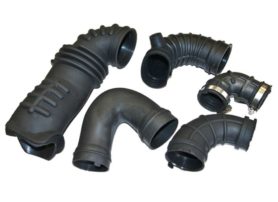Plastic Automotive Ducts Driving Out Rubber & Metal
Time was when cars were made of three materials: Steel, Glass & Rubber. Period.
Today the list of materials that go into cars is lengthy. And while carbon composites get all the hype and headlines, there is another material that is poised to become THE most prevalent material in cars.
Plastics. More specifically, thermoplastic copolyester elastomers. For one very simple reason:
Fuel efficiency, as a result of less weight: plastics simply weigh less than rubber or metal, and that’s a huge advantage.

One of the components that auto manufacturers are rapidly moving towards are high-temperature resistant air ducts. Low weight and fuel efficiency are just two of the advantages of plastic air ducts. There’s also the efficiency of utilizing a single material and single process. That saves time and money on the production end, which can lead to lower prices in the marketplace.
Plastics have another huge advantage over rubber and metal: safety. Governments in several countries around the world, including the US, have mandated the inclusion of airbags in vehicles. Many times, thermoplastics are the most cost-effective material for airbag manufacturing.
Thermoplastics demand is only expected to grow, especially in the US, Europe, and Japan, because of the rising demand for high-performance materials. But the real markets for growth will be China, Brazil, and India, due to the burgeoning automobile market, as well as the imposition of emission regulations in these countries.
But the automotive sector is just one market for the growth of this most flexible of materials: thermoplastic copolyester elastomers are quickly supplanting rubber and metals in electrical products , consumer goods, and medical devices too. In the medical device industry, thermoplastics are leading the way away from latex products, because of ever-increasing environmental concerns, biohazards, and skin sensitization issues. This is driving the demand for thermoplastics, replacing other materials such as polyvinyl chloride (PVC) and silicone rubber used in medical devices.